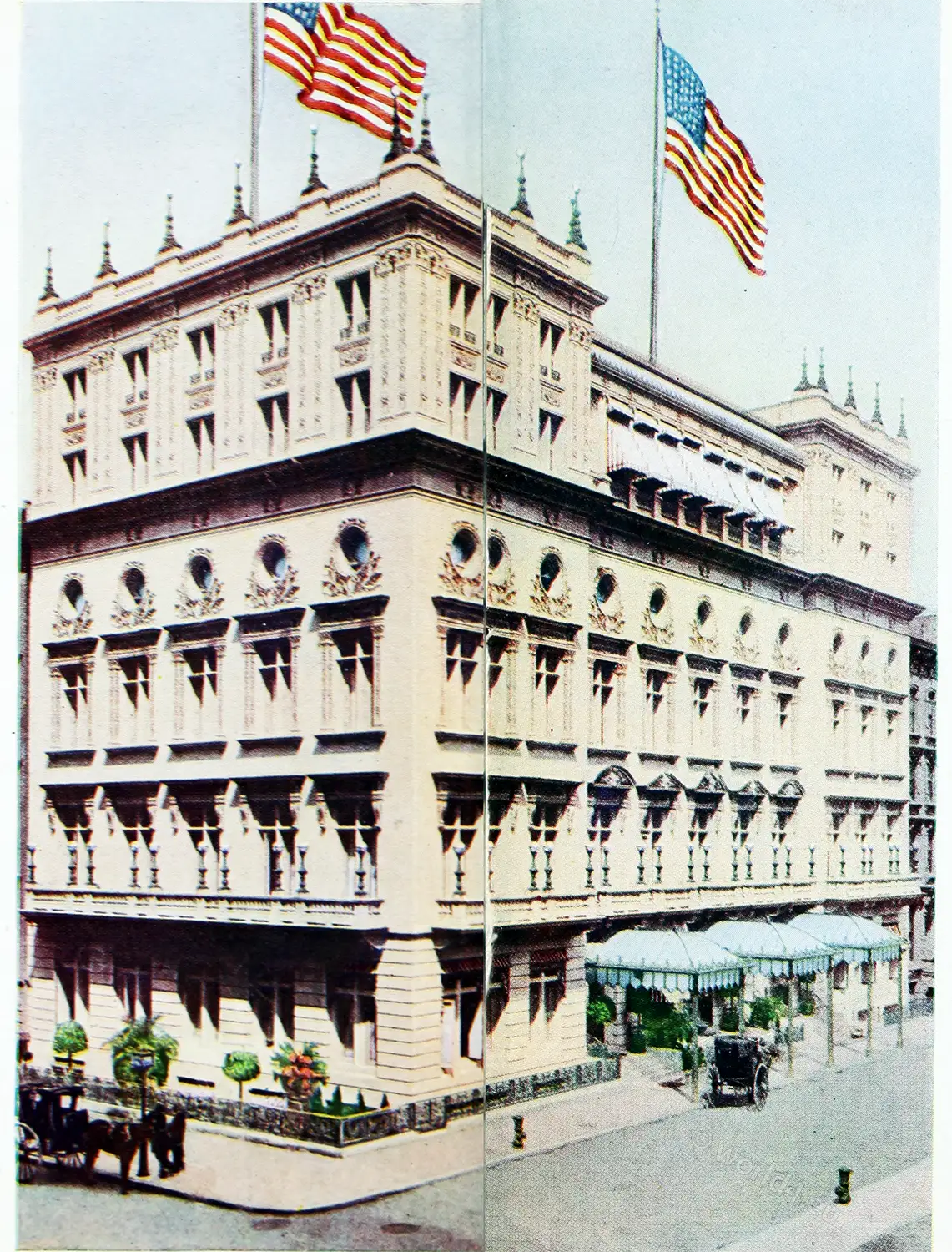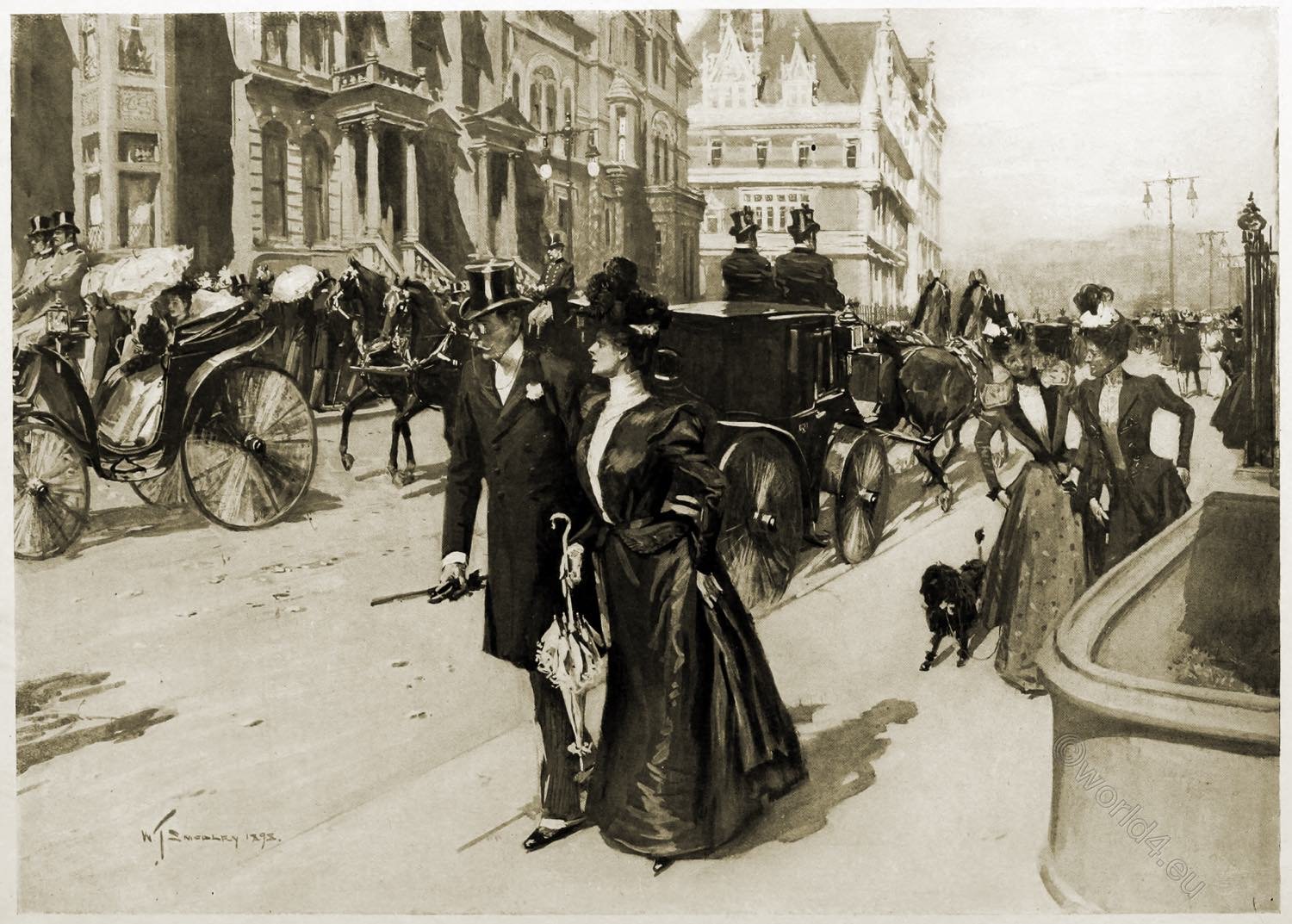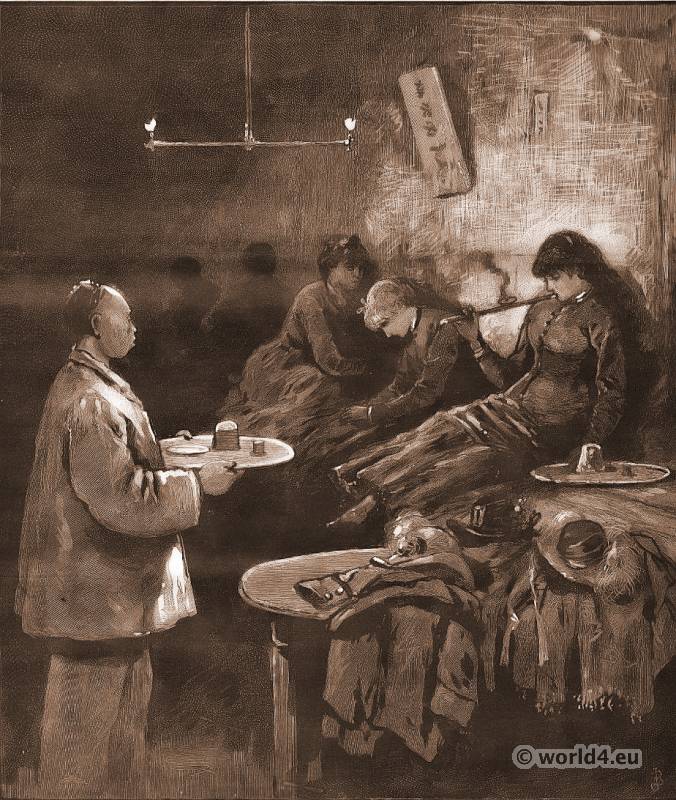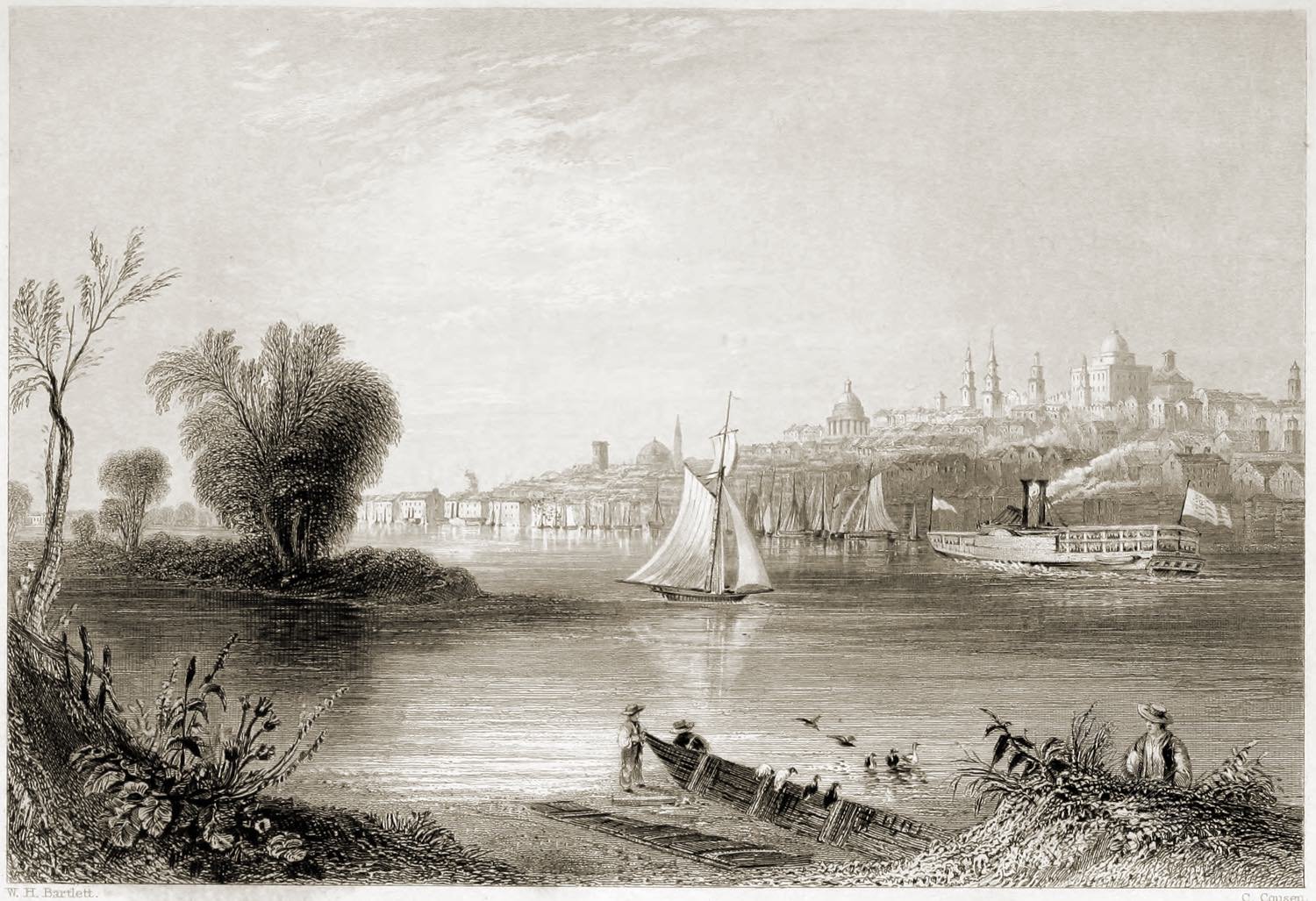VIEWS OF EARLY NEW YORK
New York in 1801
by William Gilbert Dames
THE picture presented to us shows little with which we are familiar on either side of the river. The fishermen on the Long Island shore would now find small opportunity to pursue their vocation in front of the warehouses, amid the puffing tugs and steamers, and beneath the lofty bridge which occupy the then vacant space, while their vision would be surprised by the equally impressive towering buildings and massive wharves which have replaced the old structures of New York. Even the few church spires which then formed such prominent features of the landscape, and still remain in the lower part of the city, are so dwarfed by their surroundings as to be barely discernible.
But at that time these were so conspicuous as to be the first objects to attract our attention. First, and most obvious to the sight, is Trinity Church at the head of Wall Street, its tall steeple dominating all the others, being on the building erected in 1788 to replace the one destroyed by fire during the Revolution, to be, in its turn, taken down to make room for the present stately edifice consecrated in May, 1846. The spire next on the right I imagine to belong to the Presbyterian Church in Wall Street, near Broadway, which was built in 1719, and enlarged in 1748. Rebuilt on a greater scale in 1810, it was destroyed by fire in 1834, restored the following year, and occupied until 1844, when it was taken down, the congregation having acquired a new site on Fifth Avenue, between Eleventh and Twelfth streets, which it still occupies.
Immediately to the north of the Wall Street Presbyterian Church stood the Scotch Covenanters Church, on the south side of Cedar Street, and its steeple is probably the northerly one of the three clustered together, but the latter may be that of the Middle Dutch Church on Nassau and Cedar streets, on the ground now occupied by the building of The Mutual Life Insurance Company of NewYork. Next, to the right, appears the spire of the North Dutch Church, completed and opened for public worship on May 25, 1769, a fine stone building measuring one hundred by seventy feet, on the corner of William and Fulton streets.
Almost up to this time the services in the Dutch Reformed churches had been held in the mother tongue, but the increasing use of the English language had become so marked, especially among the younger people, that it became necessary to make a change, and in 1764 English was used in the Middle Church, to the great wrath of the elderly conservatives. Dutch, however, continued the language in the South or Garden Street Church until 1803.
Passing on to the right, the next tall spire is that of St. Paul’s Church, erected in 1766, where, during the days of the English occupation of the city, Major Andre, Lord Howe, and Sir Guy Carleton attended the services, and with them the English midshipman who afterward became William IV.
Immediately after his inauguration as first President of the United States, Washington, together with all the civil and military dignitaries who had graced the occasion, repaired thither for public worship, and during his residence in the city he retained a pew there, and constantly attended the services. It has frequently since been the scene of stately ceremonies, not the least imposing of which were the funeral services held under the auspices of the Sons of the Revolution in honour of the late President McKinley, on the 18th of September, 1901.
The eye next rests upon the Brick Church then standing at the corner of Beekman and Nassau streets, upon ground which is now partly occupied by the building of the New York Times, and which was built in 1768 in the fields, and quite out of town. During the Revolution it was used as a hospital, but restored to ecclesiastical purposes thereafter, and continued as a place of worship until 1854, when the congregation removed to their present building at the corner of Fifth Avenue and Thirty-seventh Street. It remained for years a branch of the Presbyterian Church in Wall Street, and the formal separation and its erection to the dignity of an independent church did not occur until 1809.
Last on our list towers the spire of St. George’s Church on the Chapel Hill, at the corner of Beekman and Cliff streets, built in 1748 as a chapel of Trinity Church, and made an independent organisation in 1809. In 1846, Mr. Peter G. Stuyvesant gave the church some lots of ground on Rutherford Place and Sixteenth Street, sufficient for a new church and rectory, and the parish erected buildings on that site which it still occupies.
This brief review of the church steeples shown in our picture makes it clear that our fathers did not lack opportunities for religious instruction and worship, and justifies the remark of Mr. Felix Oldboy when he terms the New York of that day “the paradise of churches.”
Having considered the ecclesiastical buildings with sufficient fullness, we may properly turn our attention to the more worldly features of the landscape, but I cannot attempt with any confidence to identify the other buildings shown. I am inclined to think that the high roof, to the right of Trinity and the two other steeples, covers the new City, afterward Federal, Hall, which stood on the north side of Wall Street, opposite Broad Street extending across what is now Nassau Street, but I do not venture to speak with certainty.
Fraunce’s Tavern *), the City Hotel, the Tontine Building, the Golden Hill Inn, and many other landmarks of the old city, are, doubtless, there, but cannot be recognised. South Street had not then been reclaimed from the river, and Water Street was the city’s front on the east side—along it was extended the shipping of the port, as the North River with its width and direct continuation of the bay was thought to afford only an unsafe and hazardous anchorage. Along the shore, from the Battery to Peck Slip, the ships lay at the wharves, or at anchor in the river, and above were the shipyards—then scenes of busy industry. Here and there were receiving docks, as at Coenties Slip, Wall Street, and Maiden Lane, which were afterward filled up to make the broad spaces which are now found at the foot of those streets.
*) Fraunces Tavern is a museum and restaurant in New York City, United States. It is located at 54 Pearl Street at the corner of Broad Street in the Financial District of Lower Manhattan (United States). The location played a prominent role in the history before, during and after the Revolution of the Thirteen Colonies. At various points in its history, Fraunces Tavern served as George Washington’s headquarters, a site for peace negotiations with the British, and housed federal offices in the Early Republic. Fraunces Tavern has been owned since 1904 by Sons of the Revolution in New York State Inc. which undertook a major conjectural reconstruction and claims it is the oldest surviving building in Manhattan. The museum interprets the building and its history, along with varied displays of art and artifacts. The tavern is a tourist site and is part of the American Whisky Trail and the New York Freedom Trail. It is listed on the National Register of Historic Places and is a designated New York City landmark. In addition, the block on which Fraunces Tavern is located is a National Historic District and a New York City designated historic district.
The Fly Market, so called, a corruption from V’lei or Valley, from a stream which ran through Maiden Lane, the favourite location for the laundry work of our mothers, consisted of three market houses on that street extending from Pearl Street to the river, and from the slip connected with it a ferry ran to Brooklyn.
Before passing to the consideration of the general condition of the city at that time, our engraver deserves a moment’s attention. “Engraving,” says General James Grant Wilson in his “Memorial History of the City of New York ” (Vol. IV, p. 357), “did not antedate sculpture in its artistic and technical development, although a number of engravers, most of them foreigners, began to practise their calling in this city in the last decade of the Eighteenth Century,” and among the names he mentions as prominent in the art at that time is that of William Rollinson, by whom the engraving before us was made.
The artist who prepared the drawing, John Wood, has not handed down his fame to posterity in any other work than this, so far as I can ascertain. The plate is most accurately and artistically engraved, and will bear the closest examination under the most powerful glasses.
The city of our homes and our love arose from the destruction of the Revolutionary period like a phenix from its ashes. With her population scattered, her commerce destroyed, most of her buildings burned, ruin and desolation on every hand, she went to work with undaunted courage, unrivalled energy, and far-seeing sagacity, immediately upon the withdrawal of the British troops in 1783, to rebuild the Metropolis of the West.
The fact that she became the seat of the new government was unquestionably a strong factor in her favour, and in 1801 she had already acquired a population of between fifty and sixty thousand. An estimate of the funds required for the support of the city’s institutions for the year 1800, which has been preserved by General Wilson, gives us a good idea of the responsibilities the city authorities of those days had to bear, and forms a marvellous contrast to the budget of the present city.
For the almshouse the sum of thirty thousand dollars was needed, an amount which seems disproportionately large, and which may have been in some degree attributable to the losses incurred in the Revolution by those who were too old or too helpless to restore their fortunes. For the bridewell, or workhouse, five thousand dollars was required, and for the support of the prisoners three thousand dollars was appropriated.
In view of the cost of our present police system, the maintenance of the watch for twenty-five thousand dollars seems idyllic, as does an appropriation of five thousand dollars for streets. To this last must be added other items which seem properly to belong to the same subject, such as lamps to cost fifteen thousand dollars for being kept in order and lighted on nights when there was no “light moon,” and wells and pumps, for fire and domestic purposes, for which twenty-five thousand dollars were needed.
The Manhattan Company, which had been chartered the year before, had already gone into the banking business under its charter, but had done very little in the line of its ostensible purpose of supplying the city with pure water.
For roads about the city seventy-five hundred dollars were appropriated. But even in those days, which so many people who know little about them consider purer and better than these so far as politics and politicians are concerned, our predecessors showed their appreciation of the advantages to be derived from the useful application of money by making appropriations for “contingencies” of twenty-nine thousand four hundred and fifty dollars, and for “city contingencies” of seventy-five hundred dollars, moneys doubtless intended to be applied where they would do the most good, as the contingencies might arise.
The city then occupied only the lower end of the island. The Battery was the favourite promenade. Many of the prominent merchants lived along State Street, and in Pearl Street, over their stores. The banks and financial institutions were in Wall Street, where also resided many of our ancestors, and their wives went shopping in William Street.
The only theatre was the one on Park Row, between Ann and Beekman streets, called the Park Theater, which was opened in 1798, and there appear to have been no other public amusements. There was much social life, but considering the proportion of the number of churches to the population, these must have afforded the principal opportunities for social gatherings.
I have enumerated those conspicuous by their steeples, but there were many others, such as the Garden Street (or Exchange Place) Church, Grace Church on the corner of Rector Street and Broadway, where the Empire Building now towers, the French Church in Pine Street, Christ Church in Ann Street, and St. Peter’s in Barclay Street, built in 1786, the home of the oldest Roman Catholic congregation in the city.
I can find no words to conclude this brief sketch better or more appropriate than those used by the President of the United States in his “New York,” pp. 166, 167. Says Mr. Roosevelt, speaking of this period very characteristically: “The divisions between the upper, lower, and middle classes were sharply marked.
The old families formed a rather exclusive circle, and among the large land-owners still claimed the lead, though the rich merchants, who were of similar ancestry, much outnumbered them, and stood practically on the same plane. But the days of this social and political aristocracy were numbered. They lost their political power first… . The fall of this class, as a class, was not to be regretted, for its individual members did not share the general fate, unless they themselves deserved to fall. The descendant of any old family who was worth his salt still had as fair a chance as any one else to make his way in the world of politics, of business, or of literature; and, according to our code and standard, the man who asks more is a craven.”
Source: Views of early New York by Colonial order of the acorn. New York chapter. New York, Privately printed by the De Vinne press, 1904.








